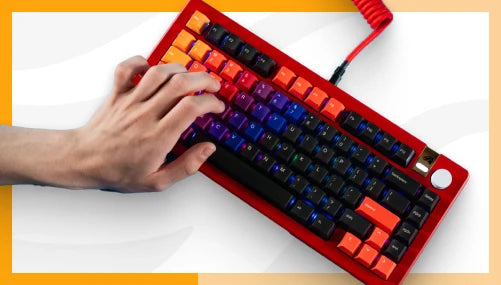
GMMK PRO Stabilizer Optimization Guide
A step-by-step guide to opening up your GMMK PRO, removing its stabilizers, and discarding the padding and excess lubricant.
Resources
Jun 25 2021
If your GMMK PRO's stabilizers feel unusually “mushy” or sluggish to return after being pressed, there may have been too much lube applied to the outside of the stabilizers. This is a QC defect from manufacturing we've identified on a small number of GMMK PRO boards. To resolve the issue we suggest disassembling your board, cleaning off the excess factory-applied lube, and removing the padding.
Removing the Stabilizers
For this process, you will need a Phillips head screwdriver. We recommend using dishes or other small containers to separate the different screws in an organized fashion.
Note: We recommend using a PH 1 sized screwdriver bit to remove the PRO's screws. Other medium-sized bits may work depending on the set.
1. Remove all keycaps and switches from the GMMK PRO and pull out the rotary knob.
2. Remove the 8 screws on the bottom of the keyboard using a Phillips head screwdriver.
3. Carefully separate the bottom chassis from the rest of the keyboard, ensuring that the wire connecting the USB-C PCB to the main PCB is not damaged.
4. Hold the chassis in place close to the rest of the keyboard and unplug the USB-C PCB from the main PCB.
5. Separate the main PCB and the switch plate from the top shell. The top shell is screwed onto the bottom chassis and should come off without any resistance.
6. Unscrew the 18 screws that hold the main PCB and the switch plate together.
7. Carefully lift off the switch plate from the PCB and remove the included padding.
8. Flip over the PCB, and remove the 8 screws that hold the stabilizers in place.
9. Remove the unscrewed stabilizers from the PCB and set them aside.
Removing Stabilizer Padding
Stabilizer pads are located below the housings of each stabilizer on the PCB. This stabilizer padding should be permanently removed to mitigate stabilizer unresponsiveness.
1. Use a blunt plastic tool, or a fingernail, to safely remove these stabilizer pads from the PCB. Removing this padding is essential for mitigating stab issues.
2. Similar to removing a sticker, gently work the tool underneath the stabilizer to lift it off the PCB. Go slow to reduce the potential for any leftover residue.
3. Once the pad is removed, carefully wipe away remaining adhesive with Isopropyl alcohol. Let the PCB dry after completing this step.
Removing Pre-Applied Lube
For this process, we recommend cue tips and Isopropyl alcohol to remove the factory lube efficiently. We will not be removing any factory lube from the inside of the stabilizer housings, just any excess lubricant on the outside.
1. Examine the plastic housing on your stabilizer for any excess lubricant coating the exterior.
2. Dip your cue tip in the Isopropyl alcohol and carefully remove any build up you may see. An opaque layer on the inside of the housing is fine.
3. Once you have removed any excess lubricant, wipe down the stabilizer’s housings with a microfiber cloth and allow them to dry.
Note: Replacing the lubricant is not a requirement; doing so comes down to your lubing preference.
Congratulations! You have successfully modified your stabilizers. Complete the process by screwing them back into their respective spots on the PCB and re-assembling your GMMK PRO.


